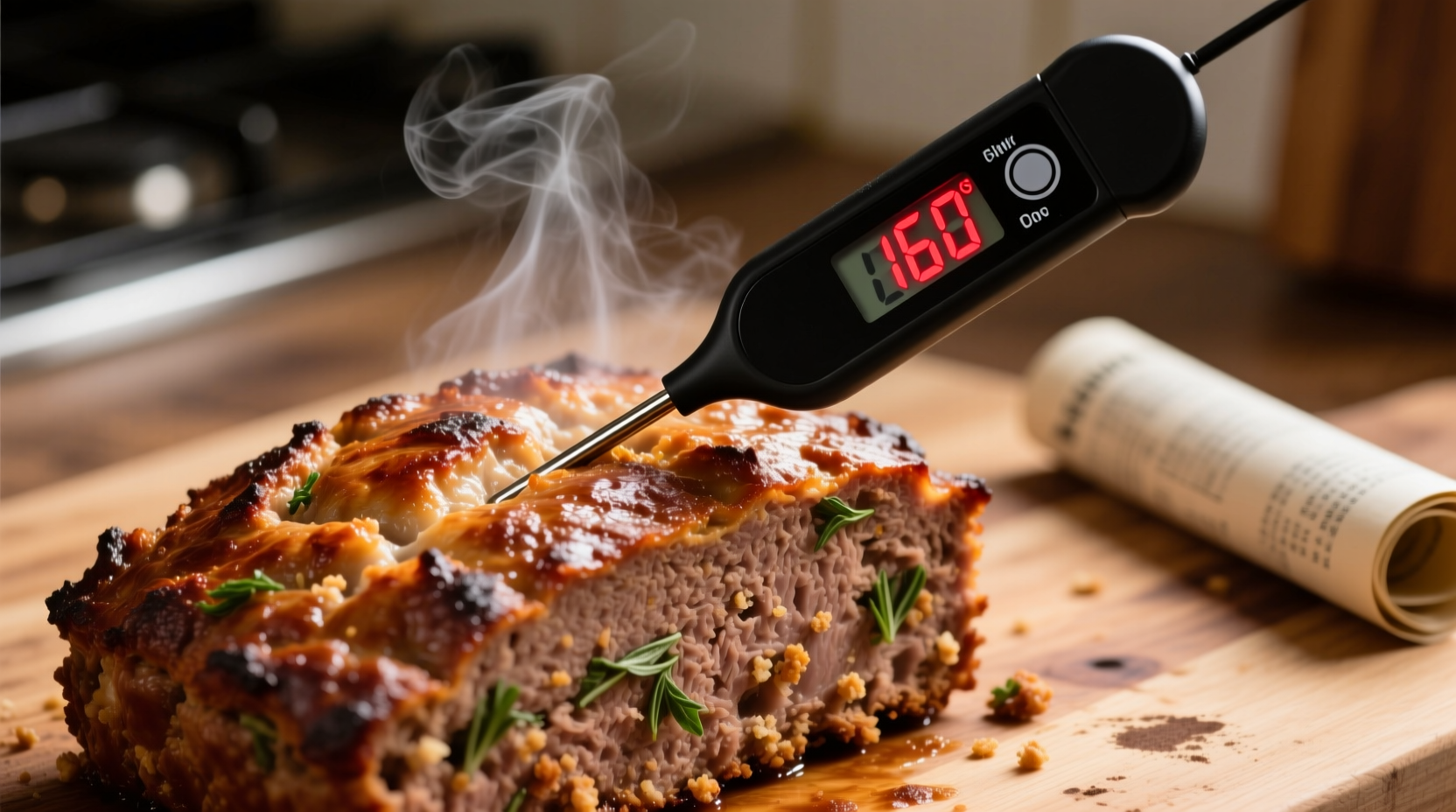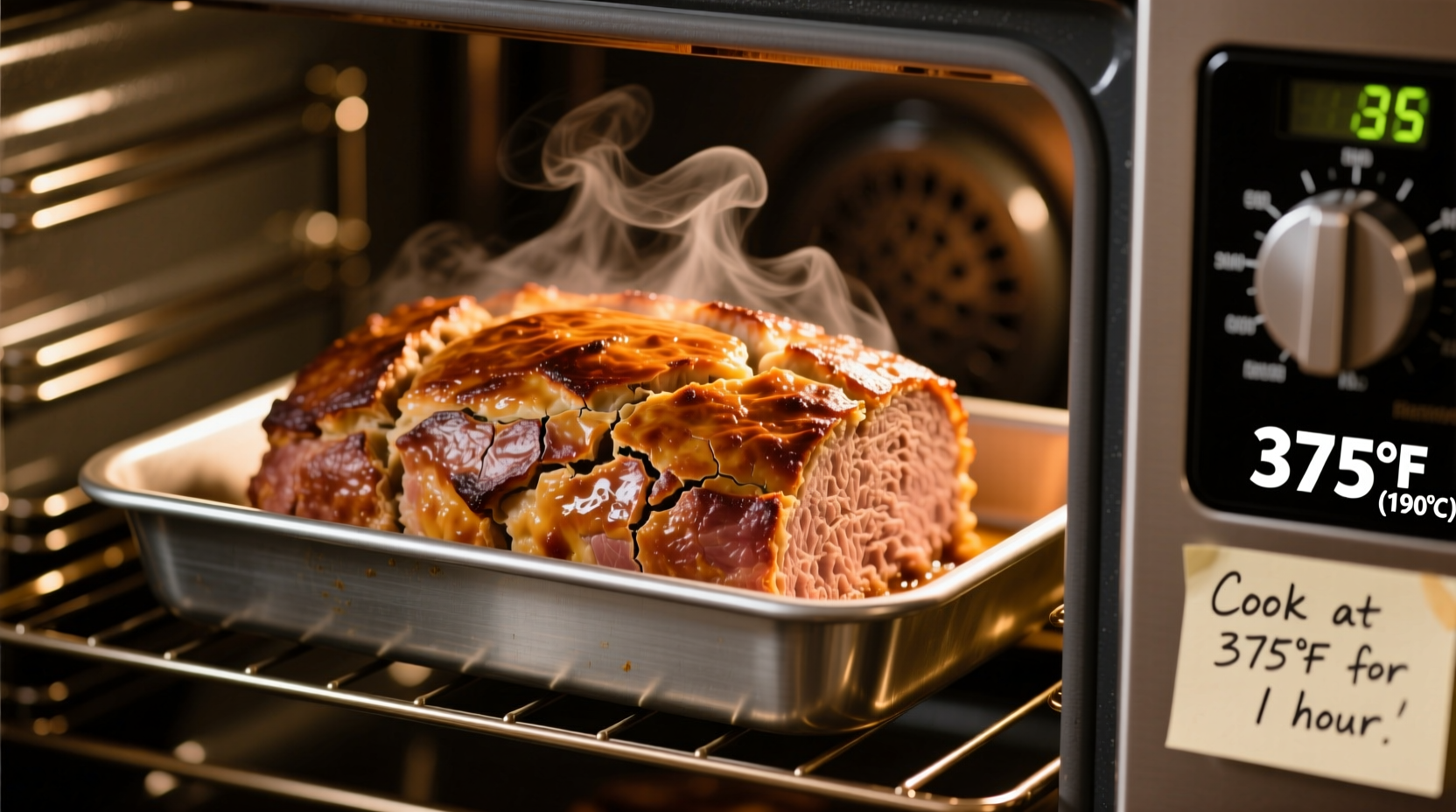The ideal internal temperature for cooked meatloaf is 160°F (71°C), as recommended by the USDA Food Safety and Inspection Service. This temperature ensures ground meat is safe to eat while maintaining optimal texture and moisture.
Getting meatloaf temperature right separates a juicy, flavorful centerpiece from a dry disappointment. Whether you're a first-time cook or a seasoned home chef, understanding the precise science behind meatloaf cooking temperatures transforms this classic comfort food from hit-or-miss to consistently perfect.
Why 160°F Is the Meatloaf Sweet Spot
Ground meats require higher internal temperatures than whole cuts because the grinding process distributes potential bacteria throughout the meat. The USDA's Food Safety and Inspection Service mandates 160°F as the minimum safe temperature for all ground meats to eliminate harmful pathogens like E. coli and Salmonella.
Professional chefs often pull meatloaf at 155°F, allowing carryover cooking to reach the safe 160°F threshold. This slight adjustment preserves moisture while still meeting food safety standards. The American Meat Science Association confirms that maintaining temperatures between 155°F-160°F creates the ideal balance of safety and texture for ground meat products.
| Temperature Range | Texture Result | Safety Status |
|---|---|---|
| 140°F-145°F | Very moist but unsafe | High risk of foodborne illness |
| 150°F-155°F | Moist with slight pink | Marginally safe for immediate consumption |
| 160°F (USDA standard) | Properly cooked, slightly firm | Completely safe |
| 165°F+ | Dry and crumbly | Overcooked, diminished quality |
Setting Your Oven: Temperature vs. Internal Target
While the internal target is 160°F, your oven temperature plays a crucial role in achieving this perfectly. Most meatloaf recipes work best at 350°F-375°F. This moderate heat allows even cooking without burning the exterior before the interior reaches safe temperature.
Higher oven temperatures (400°F+) create a desirable crust but risk overcooking the center before the exterior develops proper texture. Lower temperatures (325°F or below) extend cooking time significantly, potentially drying out the meatloaf as moisture evaporates during prolonged exposure to heat.
Timing Guidelines Based on Size
Cooking time varies substantially based on your meatloaf's dimensions. Use these guidelines as starting points, but always verify with a thermometer:
- Standard loaf pan (9x5 inch): 45-60 minutes
- Free-form loaf (2 lb): 55-70 minutes
- Muffin tin portions: 20-25 minutes
- Jumbo loaf (4 lb+): 80-100 minutes
Remember that factors like meat fat content, ingredient moisture, and oven calibration affect actual cooking time. The National Center for Home Food Preservation emphasizes that time-based cooking alone is unreliable—always confirm with a thermometer.
Proper Thermometer Technique: Avoiding Common Mistakes
Where you insert your thermometer dramatically impacts readings. For accurate results:
- Insert the probe into the thickest part of the loaf
- Avoid touching the pan bottom or sides
- Check multiple spots, especially in free-form loaves
- Wait 10-15 seconds for the reading to stabilize
Digital instant-read thermometers provide the most reliable results. The FDA Food Code specifies that temperature verification should occur in multiple locations for foods over 1 inch thick—critical for meatloaf's dense structure.

Resting Time: The Critical Final Step
Remove meatloaf from the oven when it reaches 155°F-157°F. During the essential 10-15 minute resting period, internal temperature will continue rising 3°-5°F through carryover cooking, reaching the safe 160°F threshold while allowing juices to redistribute.
Slicing too soon causes precious juices to escape onto your cutting board rather than staying within the meat fibers. This simple step makes the difference between moist and dry meatloaf.
Troubleshooting Temperature Issues
Problem: Exterior burns before interior cooks
Solution: Lower oven temperature to 325°F and cover loosely with foil after 30 minutes
Problem: Meatloaf remains pink despite reaching 160°F
Solution: This often occurs with nitrate-rich ingredients like bacon or certain seasonings. As long as temperature is verified, it's safe to eat.
Problem: Temperature stalls during cooking
Solution: This happens when moisture evaporates, cooling the meat surface. Maintain steady oven temperature—don't increase heat.
Safety Considerations Beyond Temperature
Temperature alone doesn't guarantee safety. Follow these additional precautions:
- Keep raw meat below 40°F until ready to cook
- Wash hands and surfaces after handling raw meat
- Refrigerate leftovers within 2 hours
- Consume leftovers within 3-4 days
The USDA's FoodKeeper app provides detailed storage guidelines for cooked meatloaf under various conditions, helping prevent foodborne illness beyond the initial cooking process.
Special Considerations for Different Meatloaf Variations
While 160°F remains the universal standard for ground meat safety, certain variations require attention to additional factors:
- Poultry-based meatloaf: Requires 165°F internal temperature per USDA guidelines
- Glazed meatloaf: Apply sugary glazes during the last 15-20 minutes to prevent burning
- Meatloaf muffins: Cook 5-10 minutes less than standard loaf due to increased surface area
- Convection ovens: Reduce temperature by 25°F and check 10-15 minutes early
Understanding these context boundaries ensures perfect results regardless of your recipe variation. The FDA's Food Code specifically addresses modified cooking methods, emphasizing that alternative preparations still require the same internal safety temperatures.











 浙公网安备
33010002000092号
浙公网安备
33010002000092号 浙B2-20120091-4
浙B2-20120091-4